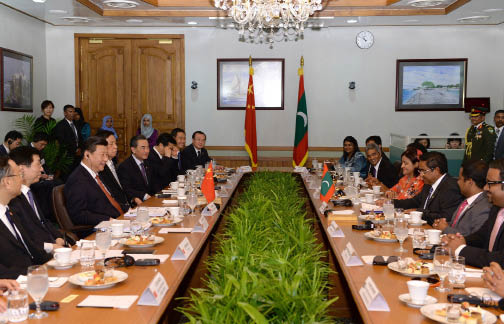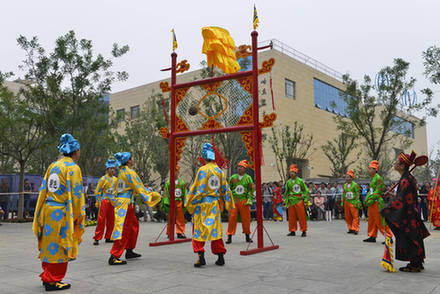China’s New Diplomatic Blueprint for South Asia
By LIN MINWANG
In September, following his attendance at the 14th Meeting of the Council of the Heads of State of the Shanghai Cooperation Organization (SCO) and his state visit to Tajikistan, Chinese President Xi Jinping began his tour of three South Asian countries: the Maldives, Sri Lanka, and India. It was President Xi’s first visit to the region since he took office. The trip gave rise to significant improvements in mapping out China’s new diplomatic blueprint on South Asia, expanding China’s neighborhood diplomacy, and reshaping world geopolitics.
|
 |
|
Talks between President Xi Jinping (second left) and President Abdulla Yameen of the Maldives (third right) in Malé on September 15, 2014. |
Pragmatic Cooperation
Xi’s visit to the Maldives was the first of its kind by a Chinese president in 42 years since the establishment of diplomatic relations between the Maldives and China. It thus held great significance in promoting bilateral ties and pragmatic collaboration between China and South Asian countries. During the visit, China reaffirmed its respect for the independence, sovereignty and territorial integrity of the Maldives, and its high regard for the Maldivian people’s choice of political system and development path according to their particular national conditions. China will continue to support and assist the Maldives’ economic development and encourage Chinese enterprises to invest in the country. The Chinese government will also support the construction of such projects as the Malé-Hulhule Island cross-sea bridge and the Youth City Project, at the same time as strengthening cooperation in national security, tourism, science, culture, education, human resource training, health care and other aspects. Meanwhile the two sides also plan to strengthen communication and cooperation on global issues such as climate change.
In Sri Lanka, China also expressed its firm support for the country’s efforts in safeguarding its independence, sovereignty and territorial integrity as well as the people’s choice of development path, and unequivocally opposed the behavior of any country or organization that violates the nation’s independence and political and social stability. The two sides promised to enhance cooperation in maritime economy such as port development and maritime security, and to advance major cooperative projects in port construction, energy, and culture. Both sides will push forward negotiations on a China-Sri Lanka bilateral free trade agreement, and the Chinese government is to encourage more enterprises to actively participate in the construction of industrial parks, special economic zones and infrastructure projects in Sri Lanka. The two sides also vowed to expand exchanges and cooperation in such fields as tourism, culture, education, and religion, and promote Chinese language learning in Sri Lanka.
President Xi’s visit to India not only improved his personal relations with newly-elected Indian Prime Minister Narendra Modi, but also elevated China-India relations to a new level of pragmatic cooperation. China announced the setting up of two industrial parks in Gujarat and Maharashtra in India and promised to provide an investment of US $20 billion in the coming five years. The two sides signed a memorandum on railway cooperation, and engaged in a discussion on bilateral cooperation in civil nuclear power field. India committed to importing high-speed railway technology from China, while the Chinese part promised to allow easier access to the Nathu La Pass for those making pilgrimages to India. Meanwhile, the two sides exchanged ideas on the sensitive border issue, reiterated their pursuit of a rational and acceptable agenda that is in both sides’ interests, and indicated their intention to settle the border issue as soon as possible.

